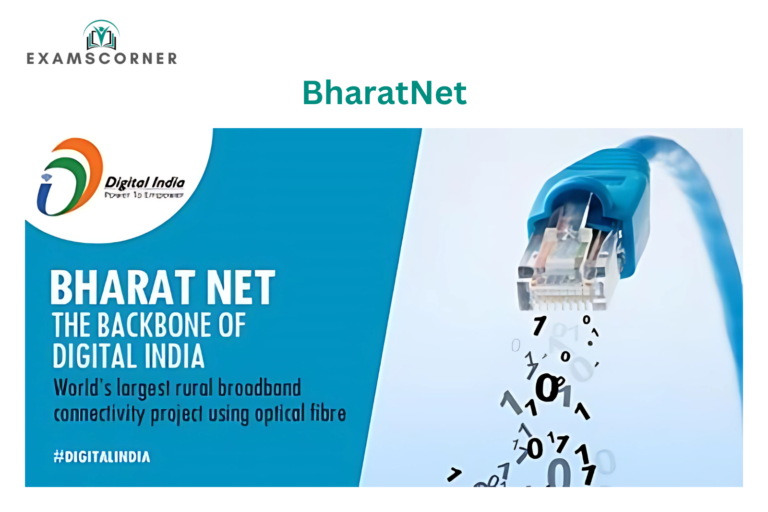The BharatNet project is one of the most transformative initiatives by the Indian government to bring digital connectivity to the rural and remote parts of the country. As of the latest updates, 2.1 lakh Gram Panchayats (GPs) have been made service-ready under the BharatNet project, marking a significant milestone in India’s journey towards a Digital India. This ambitious program aims to provide high-speed internet connectivity to all Gram Panchayats (approximately 2.6 lakh) across the nation, fostering the vision of a digitally inclusive India.
Quick Facts
Purpose: To provide last-mile connectivity to all Gram Panchayats (GPs) in India, ensuring that every rural citizen has access to fast and reliable broadband.
Type: Central Sector
Scheme Funding: Supported by the Universal Service Obligation Fund (USOF).
Implementing Agency: Bharat Broadband Network Ltd. (BBNL), which was merged into BSNL (Bharat Sanchar Nigam Limited) in 2022.
Objectives of BharatNet
The primary objective of the BharatNet project is to connect Gram Panchayats across India with 100 Mbps broadband connectivity, enhancing the digital infrastructure in rural areas and contributing to the realization of the Digital India vision. This connectivity will enable people in rural regions to access e-governance, e-education, e-health, and other digital services that will improve their quality of life.
Key Phases of BharatNet
The BharatNet project has been implemented in three phases, each designed to address different aspects of the connectivity needs across rural India.
BharatNet Phase I
The journey of BharatNet began in 2011 with the establishment of the National Optical Fibre Network (NOFN), which is now known as BharatNet. This phase focused on connecting block headquarters to Gram Panchayats (GPs) by utilizing the existing fibre network of Central Public Sector Undertakings (CPSUs) like BSNL, RailTel, and PGCIL. This initiative helped lay the foundation for the connectivity infrastructure.
BharatNet Phase II
Commencing in 2017, Phase II of the BharatNet project aimed to provide an optimal mix of media including Optical Fibre Cable (OFC), Radio, and Satellite technologies to connect the remaining Gram Panchayats. This phase adopted multiple implementation models such as:
- State-led Model
- Private Sector Model
- CPSU Model
These diverse models ensured broader coverage and flexibility in implementing the network across various states.
BharatNet Phase III
The third phase focuses on the future-proofing of the network, incorporating state-of-the-art technologies for high-speed broadband and strengthening the infrastructure to ensure its sustainability for years to come.
Current Status
The project is being implemented in three phases, with a target completion by 2025. Here’s an update on the progress:
- Phase I: Out of 1.23 lakh allocated Gram Panchayats, 1.22 lakh have already been made service-ready.
- Phase II: Out of 1.44 lakh allocated Gram Panchayats, over 71,000 have been made service-ready.
The progress of these phases signifies that BharatNet is on track to reach its goal of providing comprehensive broadband connectivity to rural India.
Approach and Implementation
BharatNet follows a collaborative approach involving Village Level Entrepreneurs (VLEs) or BharatNet Udyamis to deliver the fiber connections directly to households. These entrepreneurs will work on a 50:50 revenue-sharing basis, enabling them to take the service to the grassroots level.
VLEs will be provided with the necessary infrastructure, including routers and additional fiber optic cables, by BBNL to ensure smooth installation and connectivity.
Satellite Connectivity for Remote Areas
To ensure that even the most remote Gram Panchayats are connected, BharatNet utilizes satellite connectivity through GSAT-11 and GSAT-19 satellites. These satellites will provide internet connectivity to approximately 6700 GPs and areas that cannot be connected through conventional means like optical fiber.
Other Key Features and Benefits
National Asset
BharatNet is a project of national importance, and the network will remain a national asset that can be leveraged for long-term benefits.
Operational and Maintenance Flexibility
The operation and maintenance of the BharatNet network can be taken up by the respective state governments, ensuring better local management and sustainability.
Public-Private Partnership (PPP) Model
A PPP model is being adopted for the operation, maintenance, utilization, and revenue generation from the BharatNet infrastructure. This model encourages the involvement of private players in maximizing the potential of this vast network.
Broadband Services
The infrastructure laid down under BharatNet is now being utilized for a range of broadband services such as:
- Wi-Fi Hotspots
- Fibre to the Home (FTTH) connections
- Broadband Internet Services
Digital Services for Rural India
BharatNet aims to facilitate the delivery of various services to rural India, including:
- E-Governance Services
- E-Health
- E-Education
- E-Banking
- Public Internet Access
- Weather, Agricultural Services
- Government-to-Citizen (G2C) services
- Business-to-Business (B2B)
- Peer-to-Peer (P2P) services
These services are expected to enhance the socio-economic development of rural areas and empower citizens by offering them access to a wide range of digital services.
Conclusion
BharatNet is a pioneering initiative that is playing a crucial role in digitally connecting rural India. The project not only bridges the digital divide between urban and rural areas but also facilitates access to a variety of e-governance, e-education, and e-health services that are essential for the socio-economic development of rural communities. As BharatNet continues to expand and evolve, it is set to become a cornerstone of India’s Digital India mission, ensuring that no village or Gram Panchayat is left behind in the digital revolution.



